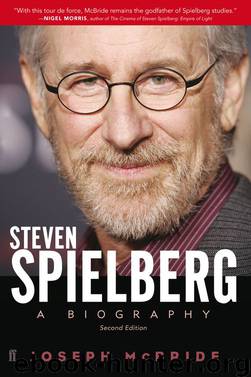Steven Spielberg by Joseph McBride

Author:Joseph McBride [Joseph McBride]
Language: eng
Format: epub
ISBN: 9780571280551
Publisher: University Press of Mississippi
Published: 2011-08-13T16:00:00+00:00
WHEN Rod Serling sold the syndication rights to his Twilight Zone series—a decision he later regretted, since the show has never stopped running—he kept the right to make a feature film version of the series. Inspired by the 1945 British anthology film Dead of Night, Serling first pitched studio executives the idea of making a Twilight Zone “trilogy” he would host. His outline said that it would be “shot in black & white for a budget of under a million dollars. The stories are separate and distinct, but have a background thread that moves one into the other.” At one time, Serling planned to include “Eyes,” the story Spielberg eventually filmed for Serling’s Night Gallery pilot in 1969. Serling also tried a different approach, taking one of the most memorable Twilight Zone programs, “It’s a Good Life” (based on a Jerome Bixby story about a little boy with sinister powers), and expanding it into a feature-length screenplay.
But Serling found no takers for a Twilight Zone movie before his death in 1975, and it was not until several years later that Warner Bros, chairman Ted Ashley revived the idea of a multipart Twilight Zone feature, acquiring the rights from Serling’s widow, Carol. Fruitless attempts were made at the studio to develop the project until Ashley’s successor, Terry Semel, mentioned the idea to Spielberg, whom he was trying to lure into a long-term, nonexclusive relationship with Warners, similar to Spielberg’s long-standing relationship with Universal. Spielberg responded with immediate enthusiasm to the prospect of paying homage to a TV series that had been one of the formative influences on his youthful imagination.
Spielberg thought a big-screen Twilight Zone anthology would not only appeal to baby boomers and the many other fans of the series, but that it also would be a perfect opportunity for a collaboration with his friend John Landis, the irreverent director of Animal House and The Blues Brothers. In April 1982, Spielberg and Landis agreed to produce Twilight Zone—The Movie together (each taking 5 percent of the gross profits) and to direct separate segments of what ultimately became a five-part feature, costing a total of about $10 million. Landis planned to write original scripts for his own two segments (including a brief prologue featuring Dan Aykroyd and Albert Brooks). To write the rest of the film, Spielberg brought in Richard B. Matheson, the author of Duel and one of the principal writers of Serling’s TV series.
The first script Matheson wrote for the Twilight Zone movie was based on a Halloween story Spielberg had been planning to direct for MGM. Matheson described it as the story of “a bully who’s mistreating all these young trick-or-treating kids, and the supernatural world gets him for it. Creatures—real live monsters—start chasing him around.” Eventually, the bully finds that his monster mask cannot be removed from his own face. This revenge fantasy was put aside when Spielberg decided to remake a I960 Twilight Zone program, “The Monsters Are Due on Maple Street,” about neighbors consumed with the paranoid fear that one of them may be an alien infiltrator in human guise.
Download
This site does not store any files on its server. We only index and link to content provided by other sites. Please contact the content providers to delete copyright contents if any and email us, we'll remove relevant links or contents immediately.
| Direction & Production | Reference |
The Kite Runner by Khaled Hosseini(5061)
Gerald's Game by Stephen King(4556)
Dialogue by Robert McKee(4306)
The Perils of Being Moderately Famous by Soha Ali Khan(4156)
The 101 Dalmatians by Dodie Smith(3440)
Story: Substance, Structure, Style and the Principles of Screenwriting by Robert McKee(3384)
The Pixar Touch by David A. Price(3345)
Confessions of a Video Vixen by Karrine Steffans(3230)
How Music Works by David Byrne(3157)
Fantastic Beasts: The Crimes of Grindelwald by J. K. Rowling(2978)
Harry Potter 4 - Harry Potter and The Goblet of Fire by J.K.Rowling(2974)
Slugfest by Reed Tucker(2923)
The Mental Game of Writing: How to Overcome Obstacles, Stay Creative and Productive, and Free Your Mind for Success by James Scott Bell(2836)
4 - Harry Potter and the Goblet of Fire by J.K. Rowling(2640)
Screenplay: The Foundations of Screenwriting by Syd Field(2561)
The Complete H. P. Lovecraft Reader by H.P. Lovecraft(2499)
Scandals of Classic Hollywood: Sex, Deviance, and Drama from the Golden Age of American Cinema by Anne Helen Petersen(2453)
Wildflower by Drew Barrymore(2431)
Robin by Dave Itzkoff(2370)
